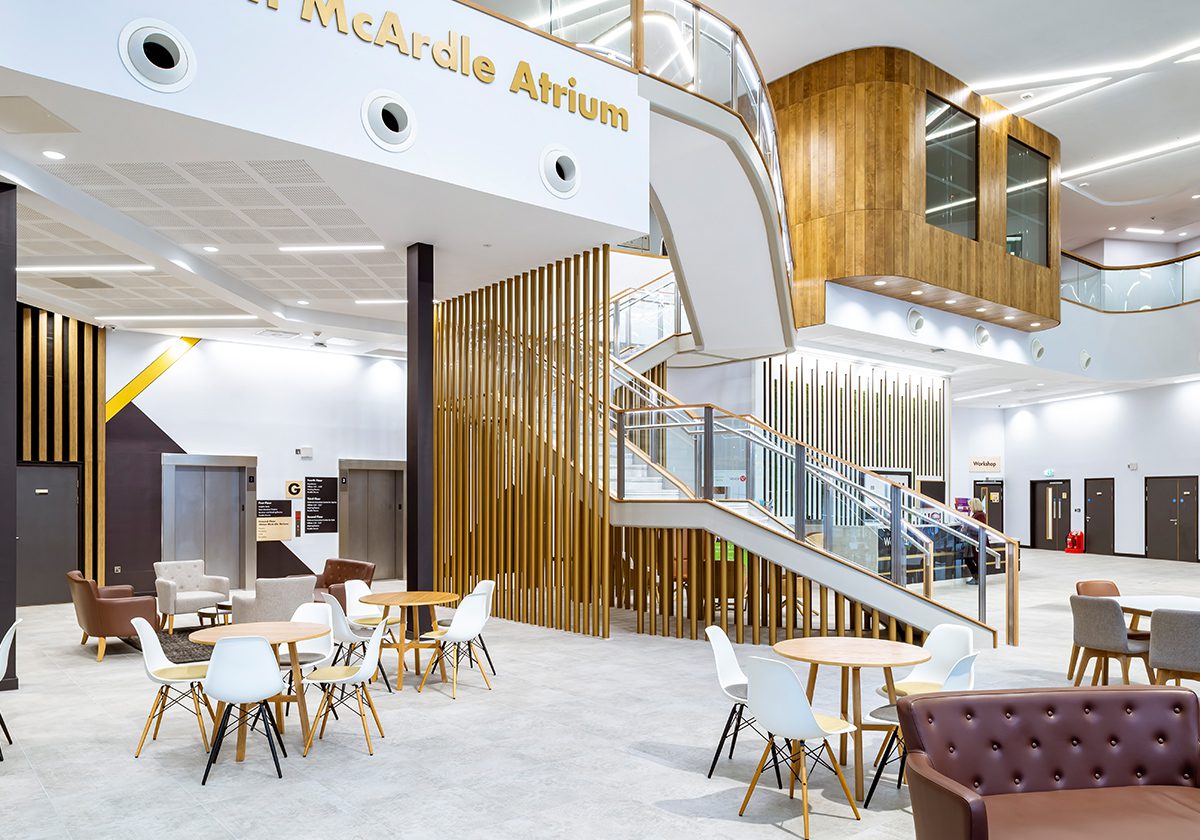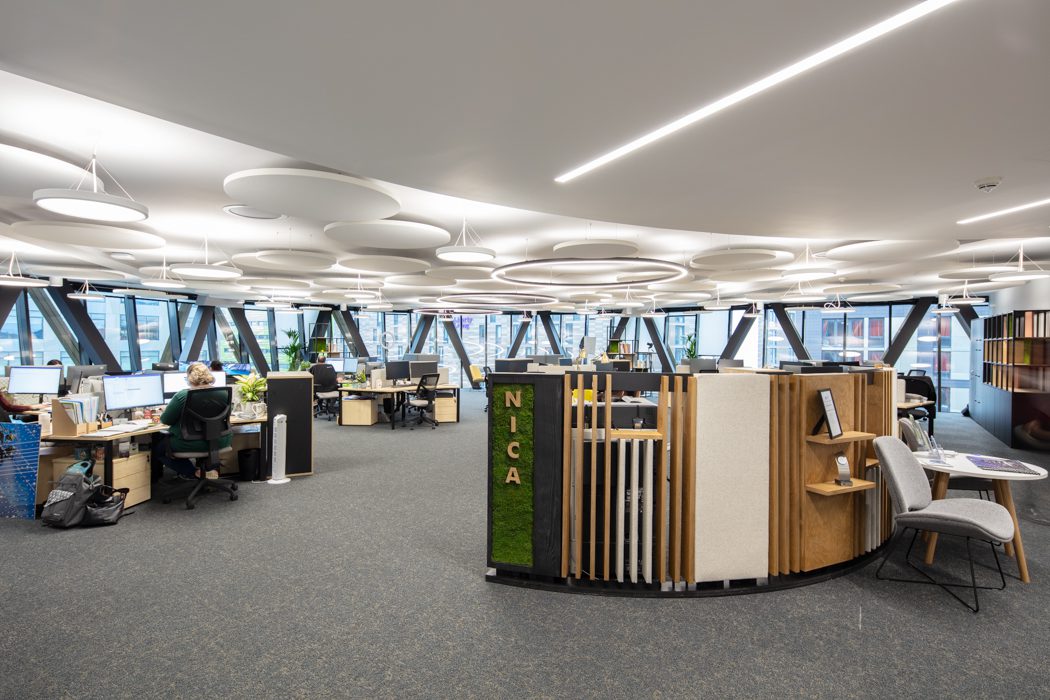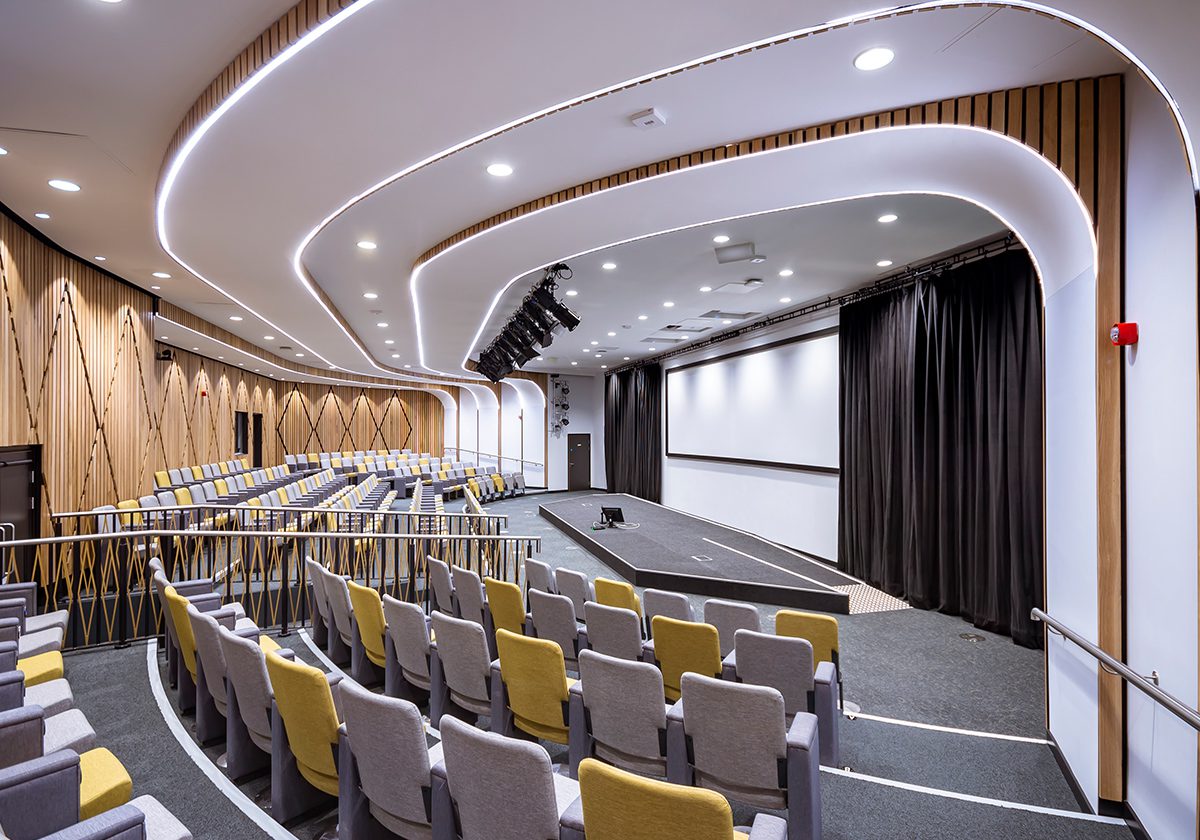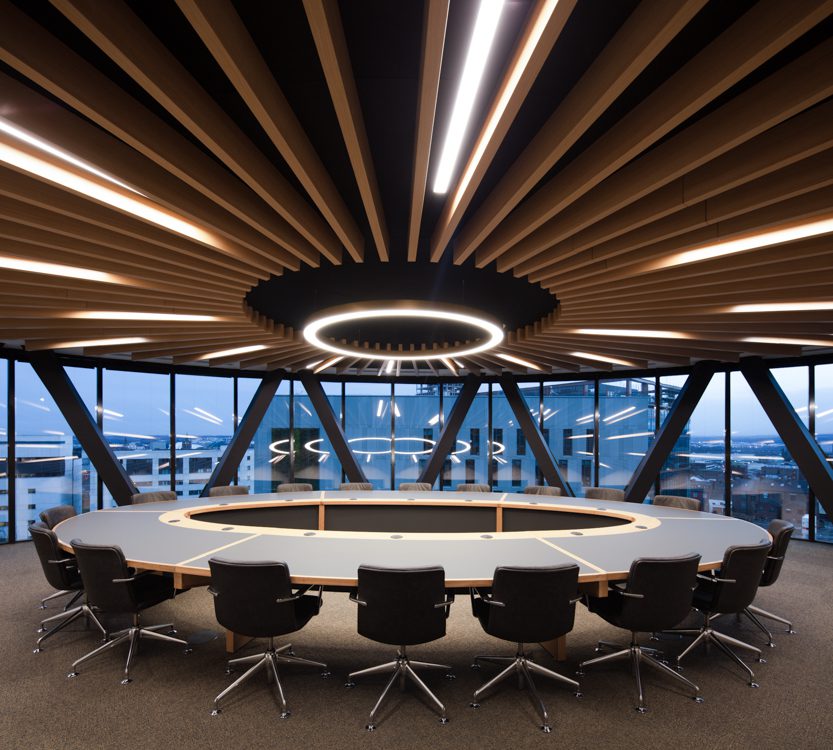A New Castle – The Catalyst
The Catalyst is the latest building to be completed at Newcastle Helix. This groundbreaking, striking facility is the new home of the UK’s National Innovation Centre for Ageing and the National Innovation Centre for Data – and is now fulfilling its promise as a centre for innovation, as well as being a stunning contribution to the Newcastle urban landscape.

The design for the 100,000 sq ft space was developed through extensive collaboration with multiple stakeholders and consultees, including Newcastle University, the two National Innovation Centres, local and national businesses, commercial organisations, specialist organisations like the RNIB, the Thomas Pocklington Trust, the Alzheimer’s Society and other research organisations, such as Stirling University’s Dementia Services Development Centre.
‘The building is located on the site of the old Scottish & Newcastle Brewery in the centre of Newcastle, now named The Helix,’ Design North’s Scott Stewart tells us. ‘This is a redevelopment of a cluster of buildings supporting science, research and innovation. The site was already selected before we got involved. ‘They were previously dispersed around various sites including The Helix, Newcastle University campus and in the Newcastle city centre. ‘The building was procured by Newcastle University, on behalf of the National Innovation Centre for Ageing (NICA) and the National Innovation Centre for Data (NICD). There was going to be areas for public engagement as well as office space to lease. The building would be maintained by the University’s estate team, but operated by a third party service provider to look after the day-to-day function of the building.
'The architect’s concept for the site was innovative – it used a small footprint at the base of the building, and gradually got bigger as it went upwards, like an up-ended cone, achieving the overall gross internal area through its volume. The other feature is that it is effectively two buildings in one. The ground and first floor areas are public, and everything from the second floor upwards is essentially private. Yet the spaces have a consistency in terms of design, colour, and materiality. Our interior design worked with, and built on, the architectural concept, a testament to the success of the collaboration between the design team.’
The building hosts a suite of bespoke facilities and a range of flexible office space, which will enable the creation of a tightly coupled and supportive ecosystem between the Innovation Centres and commercial organisations here, with a focus on either delivering new insights through data analytics or delivering new products and services, which help us to age well, for longer. The design is based around ease of navigation for visitors who may have visual impairments, disabilities or walking aids, alongside the promotion of collaborative working and integration between commercial ventures and market-leading academic research specialists. Areas designed to be dementia-friendly, private product testing rooms and larger exhibition spaces all promote active research in a high-quality but comfortable environment. The Wolfson TED Talk theatre epitomises this considerate design, featuring bespoke seating and USB charging points. The tiered seating fully caters for the elderly and disabled, with wide aisles that allow the seat bases to be permanently fixed in the down position.
The main work areas for NICA and NICD were designed with just as much collaboration and consideration in mind, offering a variety of settings that give people a choice of where to work inside their defined office areas. It was vital that the look and feel of these spaces is non-corporate in look and feel. Instead, the space utilises open shelving for display of plants and the collation of culturally relevant artefacts. Spaces outside the formal working areas provide a variety of small and large areas to gather to encourage people to come out of their offices. A phenomenal amount of work went into ensuring that every aspect of the interior was considered from every viewpoint. Indeed, this approach was applied throughout the building. The building needed to encourage collaboration and inclusivity but also to communicate best practice. NICA and NICD wanted to use the building to demonstrate a process for design as well as solutions, and to be a great place to work and visit. The awarding of BREEAM Outstanding communicates not only a strong message about the outstanding design and construction elements of the building, but also acts as a flagship to the University’s and City’s commitment to the climate emergency and the targets to achieve zero carbon well ahead of the Government’s target of 2050.

Sustainability has been held at the core of the development’s ethos. The contractor, subcontractor and design team worked in coordination to deliver a building with performance above specification to support the client to operate an estate with minimised reliance on grid-energy, reduced maintenance and replacement requirements and enhanced energy performance. Collaboratively, BREEAM Outstanding was achieved at no additional cost to the client or stakeholder group. Stakeholder engagement was key to the success of this project with many sessions to present options, test ideas and debate solutions. We’re told that the word ‘compromise’ was banned; the solutions had to be agreed by all parties and not to the detriment of anyone. Everything was to be carefully considered to ensure we were not only complying with regulations but also enhancing the design to be better than recommended.
We ask Design North’s Jacqui Martin to tell us more about the design process here. ‘I had history with the client and the estates team,’ she says. ‘We were appointed after a small competitive bid process to assist the client in developing the interior design including the furniture selection, working along side the incumbent design team. The university was keen not to add cost at this stage of the project, so were nervous about bringing in another designer. Our first task was to review the interior finishes (flooring, walls, ceilings) as quickly as possible to incorporate any changes of specification. Whilst the walls were fixed, there were still opportunities to work with the end-users to develop and improve on space planning and design, by showing them lots of options. 3D visualisation was key and using lots of samples to get across design intent.
‘The main brief was to create a modern workplace and public space with inclusivity and collaboration at its core. The National Innovation Centre for Ageing wanted to ensure the needs of an ageing population were captured where possible, making sure the design considered ageing conditions such as dementia.
‘We tested concepts with various stakeholders and, after the building was opened, an event was held inviting everyone who had participated in the engagement sessions, including Voice North, the local authority and the University. The response was fantastic – they were grateful that their feedback was implemented, and overall, thought the building and the interior was outstanding.

What do they feel makes this project unique? ‘The engagement throughout the process, started by the architects, and carried out by us, was perhaps unique,’ Jacqui considers. ‘It’s rare that interior design invites such public consultation. We even had a session where we invited furniture suppliers to provide samples of chairs so we could understand the preferred features – height, with or without arms…
‘Perhaps even more unique was that we created a space that is dementia-considerate. The guidance that exists for dementia is for health or care environments, so we had to take what we thought was applicable, test it with the stakeholders, and incorporate it into the design. Everything was received really enthusiastically.’
Indeed, the furniture/finishes selection was crucial here. ‘After all, it is what people touch and feel, and engage with physically, not just observe from afar,’ Scott explains. ‘Every piece of furniture for every space was reviewed and tested before selection. An eclectic mix of furniture was selected for each space, to reinforce a non-corporate approach to the space. And then the fabrics had to be carefully selected too. We had to look beyond the standard offerings, looking at other sectors to get product inspiration.’
This attention to detail can be seen throughout – from the public spaces through to the fantastic boardroom. Design North implemented a ‘dementia considerate’ rather than ‘dementia compliant’ policy throughout the design process as the team had to look at all aspects of ageing – not just dementia. This was particularly true in the selection of furniture for the public area. A selection of different styles of furniture for the café, meeting and social areas were tested, with people asked questions relating to the seat height, arms, materiality and the results compiled to aid the final selection. The key was variety – an eclectic mix of chairs of different seat heights, upholstered, non-upholstered, with and without arms. Fabrics and finishes were then selected to create a warm and cosy feel, akin to a hospitality environment.
In addition to the interior design, Design North developed a wayfinding and sign strategy for the building. This was because the sign system usually used by Newcastle University did not fit with the aspirations of the client – and to ensure signs were dementia-friendly.
Finally, we ask Design North about their personal favourite elements of the space. Jacqui’s favourite? ‘The view from the fourth floor to the second floor. I love looking down over the handrail, which was designed by the architects to encourage leaning. It gives you a real chance to observe collaboration in action.’
And Scott’s? ‘The boardroom – for obvious reasons.’ Mic drop.

More Case Studies
Customer Stories: Baltic Apprenticeships
Baltic Apprenticeships began back in 2006 as Baltic Training Services in a portakabin in Hartlepool fuel yard, 14 years on they are now based in The Catalyst. Read more about their transformation and what they are currently working on and their plans for the future!
Customer Stories: Urban Foresight
Urban Foresight was established in Newcastle upon Tyne in 2011 as the world’s first dedicated smart city consultancy. They set out to become a mission-driven business focused on using technology, data and new ways of working to transform local services and infrastructure.


